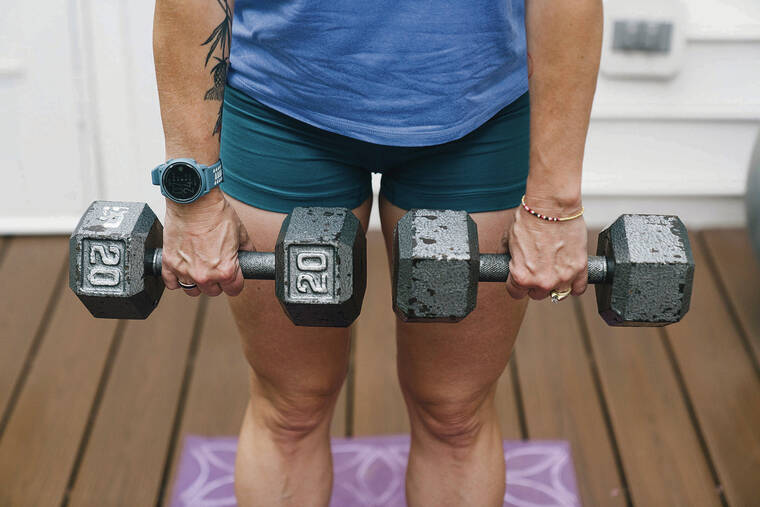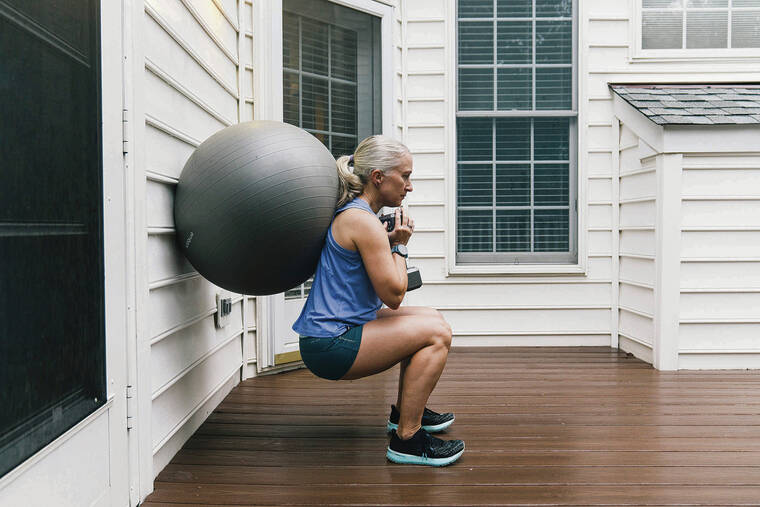How to exercise during menopause

NEW YORK TIMES
Alison Gittelman, an experienced marathoner and triathlete, uses weights while exercising at her home in Chantilly, Va. Gittelman incorporated more strength training into her exercise routine once she entered menopause.

NEW YORK TIMES
Alison Gittelman, an experienced marathoner and triathlete, uses weights while exercising at her home in Chantilly, Va. Gittelman incorporated more strength training into her exercise routine once she entered menopause.


When Alison Gittelman turned 49, she found that she couldn’t run as fast or as long as she had before. She was an experienced marathoner and triathlete, but suddenly, as she entered menopause, her heart rate was unusually elevated while running. Her joints hurt. She gained weight. She started experiencing debilitating menstrual cramps.
“I hadn’t anticipated this at all,” said Gittelman, now 51. “I thought I would breeze through menopause.”
Soon, Gittelman realized that she had to adjust her exercise routine. She started to run less and rededicated herself to strength training and mobility exercises.
Whether you work out regularly or you’re just building a fitness habit, exercise can feel harder as you reach menopause, which typically occurs in your 40s or 50s. But that doesn’t mean you should hang up your sneakers. “Exercise can be a tool to build up your resilience to the shifts that are going to happen,” said Alyssa Olenick, an exercise physiologist who studies metabolism and menopause.
In your mid-40s, your ovaries start producing less estrogen and other reproductive hormones. This transitional phase, called perimenopause, lasts between four and eight years on average. Then, your estrogen plummets.
Beyond regulating reproductive function, estrogen plays an important role in preserving muscle mass and in protecting the heart, blood vessels, metabolic function and bone health. With less estrogen circulating in the body, a woman’s risk for diabetes and cardiovascular disease increases. Bone density declines too, leaving women at greater risk for fractures and osteoporosis.
Don't miss out on what's happening!
Stay in touch with breaking news, as it happens, conveniently in your email inbox. It's FREE!
Physical activity can act as a buffer against these changes and bolster your long-term health. Historically, there hasn’t been much fitness advice tailored to women in their 40s, 50s and 60s because of the relative lack of research on women, particularly within exercise science. But researchers now understand that women need to train strategically during menopause to accommodate their shifting physiology.
“If there was ever a time to start exercising, menopause is the time,” said Dr. Carla DiGirolamo, a reproductive endocrinologist who specializes in menopause. “It can be a game changer,” she said.
Building muscle
When it comes to exercise during menopause, “we need to talk about muscle,” said Abbie Smith-Ryan, a professor of exercise physiology and nutrition at University of North Carolina at Chapel Hill. Smith-Ryan’s research has found that maintaining muscle mass may help mitigate menopause-related symptoms such as hot flashes and sleep problems.
Muscle mass and muscle function both naturally wane as you age, and that process can begin as early as your 30s. For women, the decline steepens during perimenopause, because estrogen is essential for building and sustaining muscle mass. Without estrogen, “muscle starts to shrivel up,” DiGirolamo said.
As muscle mass declines, your body has a harder time regulating blood sugar levels because muscle is one of the biggest consumers of glucose in the body. This can contribute to insulin resistance and an increase in body fat. To preserve muscle mass, you have to find a way to stimulate muscle development in the absence of estrogen — and that means lifting weights.
If you’re new to lifting, consider working with a trainer who can help you master the mechanics of each movement. For a well-rounded program, Olenick recommends choosing exercises that hit the major muscle groups: quads, glutes, hamstrings, chest, back and core.
The amount of weight you should lift depends on the exercise and your resistance training experience — but it should be heavy enough to feel challenging. Olenick suggests picking a weight for each exercise where, on a scale from one to 10, your effort level is a five or six. You can use resistance bands, dumbbells, machines at the gym or your own body weight. If you can perform the exercises quickly or don’t feel like you need rest between sets, add more weight. As you become more comfortable, increase your effort level to a seven or eight.
Aim for two to three days of resistance training per week. Remember to mix up the exercises to target different muscles, which can help with injury prevention.
Increase intensity
Aerobic exercise should also be a staple in your exercise routine, since middle-aged women are at higher risk for cardiovascular disease and diabetes. Easy- and moderate-intensity cardio workouts still offer health benefits, but during menopause, higher-intensity exercise is even better, Smith-Ryan said. It can help preserve muscle and metabolic health.
If you haven’t been exercising regularly, start with one or two higher-intensity days a week. You can walk, bike, swim or hop on the elliptical. Alternate between one minute at an effort level where it’s hard to have a conversation and one minute of recovery. Work your way up to 10 sets.
Try jump training
To improve bone health, incorporate plyometrics, or jump training, into your regimen. This type of weight-bearing exercise applies stress on the bone, which stimulates new bone growth and improves bone density. Since your muscles must generate force to perform explosive movements, these exercises can also help maintain muscle power and improve muscle quality. If you’re worried that jumping will hurt your knees, studies have found that plyometrics don’t increase pain or stiffness in older women with mild knee pain, and can even improve cartilage health.
Olenick recommends starting with light, quick bounces on two feet, called pogo hops. (Get a good warmup in first.) Try two sets of 10 hops once a week, keeping the hops close to the ground, and work up to three sets, three times a week.
As you become more comfortable, you can bounce higher and add lateral hops, jumping jacks and skipping.
Prioritize recovery
Some menopausal women may struggle to recover from workouts, because the body has a harder time repairing itself with less estrogen.
“Your body needs more TLC,” DiGirolamo said, so don’t skimp on your warmup or cooldown, take rest days and fuel your body before and after exercise, especially with protein.
Managing your fitness routine during menopause can feel overwhelming, but Smith-Ryan said that consistency is the most important thing. “You don’t have to exercise or lift heavy every single day,” she said. “Find small habits that you can do regularly.”
This article originally appeared in The New York Times Opens in a new tab.
© 2024 The New York Times Company




